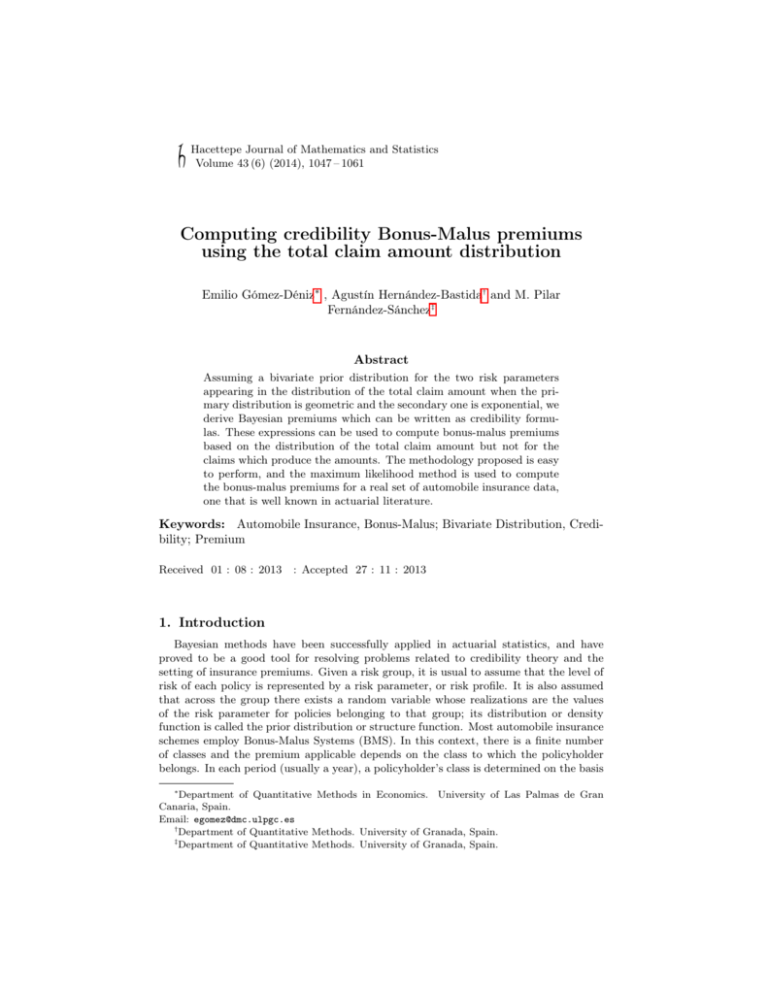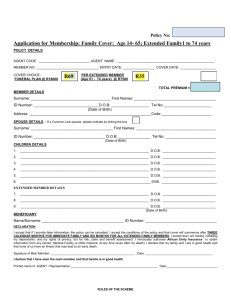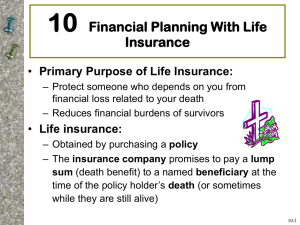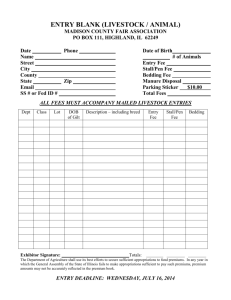Computing credibility Bonus-Malus premiums using the total claim
advertisement

Hacettepe Journal of Mathematics and Statistics
Volume 43 (6) (2014), 1047 – 1061
Computing credibility Bonus-Malus premiums
using the total claim amount distribution
Emilio Gómez-Déniz∗ , Agustín Hernández-Bastida† and M. Pilar
Fernández-Sánchez‡
Abstract
Assuming a bivariate prior distribution for the two risk parameters
appearing in the distribution of the total claim amount when the primary distribution is geometric and the secondary one is exponential, we
derive Bayesian premiums which can be written as credibility formulas. These expressions can be used to compute bonus-malus premiums
based on the distribution of the total claim amount but not for the
claims which produce the amounts. The methodology proposed is easy
to perform, and the maximum likelihood method is used to compute
the bonus-malus premiums for a real set of automobile insurance data,
one that is well known in actuarial literature.
Keywords: Automobile Insurance, Bonus-Malus; Bivariate Distribution, Credibility; Premium
Received 01 : 08 : 2013
: Accepted 27 : 11 : 2013
1. Introduction
Bayesian methods have been successfully applied in actuarial statistics, and have
proved to be a good tool for resolving problems related to credibility theory and the
setting of insurance premiums. Given a risk group, it is usual to assume that the level of
risk of each policy is represented by a risk parameter, or risk profile. It is also assumed
that across the group there exists a random variable whose realizations are the values
of the risk parameter for policies belonging to that group; its distribution or density
function is called the prior distribution or structure function. Most automobile insurance
schemes employ Bonus-Malus Systems (BMS). In this context, there is a finite number
of classes and the premium applicable depends on the class to which the policyholder
belongs. In each period (usually a year), a policyholder’s class is determined on the basis
∗
Department of Quantitative Methods in Economics. University of Las Palmas de Gran
Canaria, Spain.
Email: egomez@dmc.ulpgc.es
†
Department of Quantitative Methods. University of Granada, Spain.
‡
Department of Quantitative Methods. University of Granada, Spain.
of that assigned for the previous period and on the number of claims made during the
period. The main purpose of a BMS is to decrease the premiums for good risks and to
increase them for bad ones. With Bayesian methodology, this is achieved by dividing a
posterior expectation by a prior expectation according to an estimate derived by means
of an appropriate loss function (see Lemaire, 1979, 1985, 1995; Gómez-Déniz et al., 2002;
Sarabia et al., 2004; Denuit et al., 2007, among others).
Nevertheless, it is obvious that not all accidents produce the same individual claim
size and thus it does not seem fair to penalize all policyholders in the same way when
they present a claim. In other words, when the bonus-malus premium is based only on
the number of claims a policyholder who has an accident with an individual claim size
of 100$ is penalized by the same amount as if the accident had produced an individual
claim size of 500$. As different claims produce different claim amounts, it would seem
that the best way to build a BMS would be based on both the number of claims and on
the individual claim size. As Lemaire (2004) points out, when the claim amount is not
incorporated into the bonus-malus premium this implies an assumption of independence
between the variables "number of claims" and "claim amount", an assumption that is
open to question.
In recent years, attempts have been made to include factors other than the number
of claims in calculating bonus-malus premiums. Thus, Frangos and Vrontos (2001) and
Mert and Saykan (2005) introduced a model where the number of claims and the individual claim size were used jointly to compute the bonus-malus premiums. Based on the
independence assumption assumed in the collective risk model between these two random
variables, they computed the premium by multiplying the bonus-malus premiums based
only on the number of claims with the bonus-malus premiums based only on the individual claim size. Their empirical results show there is a positive correlation between these
two random variables, and thus the assumption of some kind of dependence between
them should be taken into account in calculating bonus-malus premiums.
If we wish to replace the distribution of the number of claims by the distribution of
the total claim amount, this will depend on two parameters, one related to the random
variable "number of claims" and the other related to the random variable "claim cost".
It is possible to transfer a relation of dependence between these risk profiles, by assuming
that both profiles fit a joint bivariate prior distribution.
Apart from looking for some kind of dependence, the bivariate prior distribution can
be justified in the following manner. The aim of the actuary is to design a tariff system that will distribute the exact weight of each risk fairly within the portfolio when
policyholders present different risks. For instance, in the automobile insurance market,
the first approach to solving this problem, called tariff segmentation, consists in dividing policyholders into homogeneous classes according to certain variables believed to be
influencing factors (a priori factors), such as the model and use of the car, the age and
sex of the driver, the duration of the driving licence, etc. Once the actuary has classified
policyholders, the premium can be established for each type of risk. However, some factors cannot be measured or introduced into the rates to calculate premiums according
to tariff-segmentation methods. Consequently, heterogeneity continues to exist in every
class defined with a priori factors. Some of these unmeasured or unknown characteristics
probably have a significant effect on the number of claims and also on the individual
claim size; for instance, in automobile insurance, swiftness of reflexes, knowledge of the
Highway Code or the behaviour patterns of the driver. Given that many claims could be
explained by these hidden features, they should be included in the tariff system. This is
the goal of experience rating or credibility theory, the underlying idea of which is that
past experience reveals information about hidden features.
In this paper, we assume a bivariate prior distribution for the two risk parameters
appearing in the distribution of the total claim amount when the distribution of the
random variable number of claims (primary distribution) is geometric and the distribution
of the random variable individual claim size (secondary distribution) is exponential. This
allows us to use the unconditional distribution of the total claim amount to compute the
premiums, which can then be written as a credibility formula. These premiums are
then used to obtain the bonus-malus premiums, based on the distribution of the total
claim amount and not only on the claims which produced the amounts. The maximum
likelihood method is used to estimate the parameters of the distribution in a real data
set concerning automobile insurance and well known in actuarial literature.
The rest of this paper is structured as follows. Section ?? presents the basic collective
risk model based on the geometric and the exponential distribution as the primary and
the secondary distribution, respectively. The bivariate prior distribution is presented in
Section ??, where we also show the marginal and the unconditional distribution of the
claim size. Credibility premiums are obtained in Section ?? and the parameters of the
unconditional distribution of the claim amount are estimated in Section ??. A numerical
application with a real data set is presented in Section ?? and the main conclusions are
drawn in the last Section.
2. The basic model
One of the main objectives of risk theory is to model the distribution of the aggregate
claim amount for portfolios of policies, so that the insurance firm can take decisions
taking into account just two aspects of the insurance business: the number of claims and
the individual claim size. Therefore, the total claim amount over a fixed time period is
modelled by considering the number of claims and the individual claim size separately. In
this paper, we assume that the premiums in a bonus-malus system should be computed
by taking into account both the number of claims and the individual claim size.
In the collective
P risk theory, the random variable of interest is the aggregate claim
defined by X = N
i=1 Xi , where N is the random variable denoting the number of claims
and Xi , for i = 1, 2, ... is the random variable denoting the individual claim size of the i-th
claim. Assuming that X1 , X2 , . . . , are independent and identically distributed random
variables which are also independent of the random variable number of claims N , it is
well-known (see Klugman et al. (2008) and Rolski et al. (1999), among others) that
the probability density function of the aggregate claim (total claim amount) is given
P∞
n∗
(x), where pn denotes the probability of n claims (primary
by fX (x) =
n=0 pn f
∗
distribution) and f n (x) is the n-th fold convolution of f (x), the probability density
function of the claim amount (secondary distribution).
In automobile insurance, when the portfolio is considered to be heterogeneous, all
policyholders have a constant but unequal underlying risk of having an accident. That
is, the expected number of claims varies from policyholder to policyholder. As the mixed
Poisson distributions have thicker tails than the Poisson distribution, the former provide a
good fit to claim frequency data when the portfolio is heterogeneous. Frangos and Vrontos
(2001), Gómez-Déniz (2002), Mert and Saykan (2005), among many others, consider the
Poisson parameter, i.e. the expected number of claims, to follow a Gamma distribution.
In this case, the unconditional distribution of the number of claims follows a negative
binomial distribution. The advantage of this model is that the distribution of the total
claim amount can be obtained in closed form expression when the secondary distribution
is assumed to be exponential. Other models considered in the actuarial literature are
the Poisson-inverse Gaussian distribution (Willmot (1987)) and the negative binomialinverse Gaussian distribution (Gómez-Déniz et al. (2008)). Both models provide a good
fit to the claim frequency data, and a recursive computation of the total claim amount
can be obtained using Panjer’s algorithm or a simple modification.
Assuming that the number of claims is represented by random variable N and that
it follows a Poisson distribution with parameter λ > 0 denoting the differing underlying
risk of each policyholder reporting a claim. Assume, moreover, that λ is distributed
according to the exponential
distribution with parameter θ1 /(1 − θ1 ), with 0 < θ1 < 1,
θ1 λ
i.e. π(λ) ∝ exp − 1−θ
, where π(λ) represents the prior distribution of λ. It is a simple
1
exercise to show that the unconditional distribution of the number of claims is given by
Pr(N = n) = θ1 (1 − θ1 )n ,
n = 0, 1, . . . ,
and therefore a geometric distribution with parameter θ1 .
Assuming that the individual claim size follows an exponential distribution (secondary
distribution) with parameter θ2 > 0, the n-th fold convolution of exponential distribution
has a closed form that is given as follows (see Klugman et al. (2008) and Rolski et al.
(1999))
f ∗n (x) =
θ2n
xn−1 e−θ2 x , n = 1, 2, . . .
(n − 1)!
i.e. it is a gamma distribution with shape parameter n and scale parameter θ2 .P
Now, it
is easy to see that the probability density function of the random variable X = N
i=1 Xi
is given by
x = 0,
θ1 ,
(2.1)
fX (x|θ1 , θ2 ) =
θ1 (1 − θ1 )θ2 exp(−θ1 θ2 x), x > 0.
Observe that the probability density function of the claim amount has a jump of size
θ1 at the origin.
3. A suitable bivariate distribution
In this section we introduce a new continuous probability density function that will
be used to derive, by mixing, the unconditional probability density function of the total
claim amount in (??) and also to compute the bonus-malus premiums proposed in this
paper.
We begin by introducing the new continuous bivariate probability density function,
as follows. It can be shown straightforwardly that
(3.1)
f (x, y) =
σγ
xα−1 (1 − x)β−1 y γ−1 exp(−σxy),
B(α − γ, β)Γ(γ)
for 0 < x < 1, y > 0, α > 0, β > 0, γ > 0, σ > 0 and α > γ is a proper bivariate
probability density function. In (??) we have that
Z ∞
Γ(z) =
tz−1 e−t dt
0
is the gamma function and B(z1 , z2 ) is the beta function given by
Z 1
B(z1 , z2 ) =
tz1 −1 (1 − t)z2 −1 dt.
0
To the best of our knowledge, the bivariate distribution presented here has not been
previously addressed in statistical literature.
Some computations provide that the distribution is unimodal with modal value at the
point
x
=
y
=
α−γ
,
α+β−γ−1
(γ − 1)(α + β − γ − 1)
.
σ(α − γ)
Now by a straightforward calculation we see that
E(XY ) =
(3.2)
γ
.
σ
The marginal distribution of X and Y , which can be obtained by integrating (??)
with respect to y and x, respectively, can be shown to be a known univariate distribution.
Thus, the marginal distribution of X is a beta distribution with parameters α − γ and
β, i.e.
fX (x) =
(3.3)
1
xα−γ−1 (1 − x)β−1 .
B(α − γ, β)
The marginal distribution of Y is given by
(3.4)
fY (y) =
σ γ Γ(α + β − γ)
y γ−1 1 F1 (α, α + β, −σy),
Γ(α + β)B(α − γ, γ)
where 1 F1 (·, ·, ·) is the confluent hypergeometric function, also called Kummer’s function,
given by
1 F1 (m, n, z)
=
∞
X
(m)k z k
,
(n)k k!
k=0
and (m)j = Γ(m + j)/Γ(m), j ≥ 1, (m)0 = 1 is the Pochhammer symbol.
Using Kummer’s first theorem we have that (??) can be rewritten as
(3.5)
fY (y) =
σ γ Γ(α + β − γ)
y γ−1 e−σy 1 F1 (β, α + β, σy).
Γ(α + β)B(α − γ, γ)
Expression (??) is reminiscent of the generalized exponential distribution given in
Bhattacharya (1966), see expression (3.1) in this paper.
Since
(3.6)
EY (Y ) =
γ(α + β − γ − 1)
,
σ(α − γ − 1)
by using (??) together with (??) and the mean of the distribution given in (??) we obtain
the covariance of (??), which is given by
(3.7)
cov(X, Y ) =
βγ
,
σ(α + β − γ)(γ − α + 1)
which admits correlation of any sign. Thus, we have
> 0 if 0 < α − γ < 1,
cov(X, Y )
>0
if α − γ > 1.
Let us now assume that the two parameters of the distribution of the total claim
amount in (??) are random and that they follow a bivariate prior distribution as in (??),
i.e. we have that
σγ
π(θ1 , θ2 ) =
(3.8)
θα−1 (1 − θ1 )β−1 θ2γ−1 exp(−σθ1 θ2 ),
B(α − γ, β)Γ(γ) 1
for 0 < θ1 < 1, θ2 > 0, α > 0, β > 0, γ > 0, σ > 0 and α > γ. The unconditional
distribution of the total claim amount in (??) can be obtained by mixing, by computing
the following integral
Z ∞Z 1
fX (x|α, β, γ, σ) =
fX (x|θ1 , θ2 )π(θ1 , θ2 ) dθ1 dθ2 .
0
0
Some algebra provides the following probability density function for the unconditional
distribution of the total claim amount.
α−γ
,
x = 0,
α+β−γ
f (x|α, β, γ, σ) =
(3.9)
βγσ γ
1
, x > 0,
α + β − γ (x + σ)γ+1
which is obviously a two piece distribution with a jump of size
Moments of order r of (??) are as follows:
(3.10)
E(X r ) =
βσ r r!Γ(γ − r)
,
(α + β − γ)Γ(γ)
α−γ
α+β−γ
at the origin.
γ > r.
In particular, we have that
E(X)
=
βσ
,
(α + β − γ)(γ − 1)
E(X 2 )
=
2βσ 2
,
(α + β − γ)(γ − 1)(γ − 2)
γ > 1,
γ > 2,
from which we can obtain the variance of the distribution, given by
var(X) =
βσ 2 (2α(γ − 1) + β − 2(γ − 1)γ)
,
(α + β − γ)2 (γ − 2)(γ − 1)2
γ > 2.
4. Credibility premiums
When the premiums are based only on the number of claims, the distribution to
be considered is, in this case, the geometric distribution with parameter 0 < θ1 < 1.
Suppose now that the prior distribution on θ1 is the beta distribution given in (??).
Given a sample information n1 , . . . , nt the posterior distribution is a beta distribution
with parameters α − γ + t and β + tn̄ and it is simple to see that the unconditional
distribution of the number of claims is given by
(4.1)
Pr(N = n) =
B(α − γ + 1, β + n)
,
B(α − γ, β)
which is the geometric–beta distribution.
In the actuarial context, the premium charged to a policyholder is computed on the
basis of the past claims made and on that of the accumulated past claims of the corresponding portfolio of policyholders. To obtain an appropriate formula for this, various
methods have been proposed, mostly in the field of Bayesian decision methodology. The
procedure for premium calculation is modelled as follows. The number of claims made
with respect to a given contract in a given period is specified by a random variable X
following a probability density function f (x|θ) depending on an unknown risk parameter
θ. A premium calculation principle (Gómez-Déniz et al. (2006) and Heilmann (1989))
assigns to each risk parameter θ a premium within the set P ∈ IR , the action space. Let
L : Θ × P → IR be a loss function that assigns to any (θ, P ) ∈ Θ × P the loss sustained
by a decision-maker who takes the action P and is faced with the outcome θ of a random
experience. The premium must be determined such that the expected loss is minimized.
From this parameter, the unknown premium µ(θ), called the risk premium, can be
obtained by minimizing the expected loss Ef [L(θ, P )]. L is usually taken as the weighted
squared-error loss function, i.e. L(a, x) = h(x)(x − a)2 . Using different functional forms
for h(x) different premium principles are obtained. For example, for h(x) = 1 we obtain
the net premium principle (Heilmann (1989), Gerber (1979) and Klugman et al. (2008);
among others). For a review of the net premium and the different premiums defined
in the actuarial setting, see Bühlmann and Gisler (2005), Gerber (1979), Gómez et al.
(2002, 2006), Heilmann (1989) and Rolski et al. (1999).
If experience is not available, the actuary computes the collective premium, µ, which
is given by minimizing the risk function, i.e. minimizing Eπ [L(µ(θ), θ)], where π(θ) is
the prior distribution on the unknown parameter θ. On the other hand, if experience is
available, the actuary takes a sample x from the random variables Xi , i = 1, 2, . . . , t,
assuming Xi i.i.d., and uses this information to estimate the unknown risk premium µ(θ),
through the Bayes premium µ∗ , obtained by minimizing the Bayes risk, i.e. minimizing
Eπx [L(µ(θ), θ)]. Here, πx is the posterior distribution of the risk parameter, θ, given the
sample information x.
Thus, in our case, if L(x, a) = (x − a)2 , the net risk, collective and Bayes premiums
are given by
1 − θ1
µC (θ1 ) =
,
θ1
β
,
µC =
α−γ−1
β+k
µ∗C =
(4.2)
= Z(t)n̄ + (1 − Z(t))µC ,
α−γ+t−1
where the credibility factor is given by Z(t) = t/(α − γ + t − 1) and n̄ is the sample
mean based only on the claim frequency observed. The subscript C indicates that the
premiums are based on the number of claims.
Now suppose that the practitioner chooses to compute the premium according to
the individual claim size, assuming that this follows an exponential distribution with
parameter θ2 > 0 and that the prior distribution on θ2 is the distribution given in (??)
with β → 0 and α = 1. In this case, (??) reduces to the gamma distribution with shape
parameter γ and scale parameter σ. Given a sample information x1 , . . . , xt the posterior
distribution is a gamma distribution with parameters γ + t and σ + tx̄. Again, it is simple
to see that the unconditional distribution of the individual claim size is given by
γσ γ
,
f (x) =
(σ + x)γ+1
and that the risk, collective and Bayes premiums are as follows:
1
µCC (θ2 ) =
,
θ2
σ
,
µCC =
γ
σ + tx̄
(4.3)
µ∗CC =
= Z(t)x̄ + (1 − Z(t))µ,
γ+t
where the credibility factor is given by Z(t) = t/(γ + t) and x̄ is the sample mean based
only on the size observed. The subscript CC denotes that the premiums are based on
the individual claim size.
Frangos and Vrontos (2001) and Mert and Saykan (2005) introduced a model where the
number of claims and the individual claim size were used jointly to compute the bonusmalus premiums. According to the independence assumption assumed in the collective
risk model between the two random variables, they computed the premium by multiplying
the bonus-malus premiums based only on the number of claims by the bonus-malus
premiums based only on the individual claim size, i.e. multiplying (??) by (??).
The most reasonable model consists in working with both random variables but not in
a separate way. To do so, let xi , i = 1, 2, . . . , t be independent and identically distributed
random variables following the probability density function (??), i.e.
f (x1 , . . . , xt ) = θ1t θ2t (1 − θ1 )t exp(−tx̄θ1 θ2 ),
provided that xi > 0, i = 1, 2, . . . , t. Let us suppose that (θ1 , θ2 ) follows the prior distribution π(θ1 , θ2 ) given in (??), then the posterior distribution of (θ1 , θ2 ) given the sample
information (x1 , . . . , xt ) is of the same form as in (??) with the updated parameters
(α∗ , β ∗ , γ ∗ , σ ∗ ) given by
α∗
=
α + t,
∗
=
β + t,
γ∗
=
γ + t,
σ∗
=
σ + κ,
β
P
where κ = ti=1 xi .
When xi = 0, i = 1, 2, . . . , t then the posterior distribution has the following updated
parameters
α∗
=
α + t,
β∗
=
β,
γ∗
=
γ,
∗
=
σ,
σ
Now, denoting the unknown risk premium by µ(θ1 , θ2 ) = µ(Θ), and again using the
square–error loss function, the net risk, collective and Bayes premiums are given by
Z
(4.4)
µ(Θ) =
xf (x|Θ)dx,
Z
(4.5)
µ =
µ(Θ)π(Θ)dΘ,
Z
µ∗ =
µ(Θ)π(Θ|x)dΘ,
(4.6)
respectively.
As mentioned above, it is clear that under the model Assumed, the net risk premium
(??) is given by
1 − θ1
θ1 θ2
while the net collective premium in (??) is described by
Z ∞Z 1
βσ
µ =
µ(Θ)π(θ1 , θ2 ) dθ1 dθ2 =
,
(α
+
β
−
γ)(γ − 1)
0
0
(4.7)
µ(Θ) = E(X|Θ) =
γ > 1.
Finally, the net Bayes premium in (??) is given by
(4.8)
µ∗ =
(β + t)(σ + tx̄)
,
(α + β − γ + t)(γ + t − 1)
γ > 1,
for xi > 0, i = 1, 2, . . . , t. When xi = 0, i = 1, 2, . . . , t, the net Bayes premium is
(4.9)
µ∗ =
βσ
,
(α + β − γ + t)(γ − 1)
γ > 1,
Observe that (??) can be rewritten in the two following ways. Firstly, some simple
computations provide that
µ∗ = H(α, β, γ, t)µ∗CC ,
where
H(α, β, γ, t) =
(β + t)(γ + t)
.
(α + β − γ + t)(γ + t − 1)
And secondly,
µ∗ = Z(t)h1 (x̄) + (1 − Z(t))h2 (µ),
where the credibility factor Z(t) is given by
(4.10)
Z(t) =
t
t+α+β−γ
and the functions h1 (·) and h2 (·) are given by
h1 (x)
=
h2 (x)
=
(β + t)x + σ
,
γ+t−1
γ−1
x.
γ+t−1
When t → ∞ we have that, since h1 (x̄) → x̄ and Z(t) → 1, then µ∗ → x̄ and when
t → 0 it is easy to see that µ∗ → µ. Thus, it is reasonable to assume that when the
sample size tends to infinity the Bayes premium converges to the sample mean, and it
converges to the collective premium when the sample size tends to zero.
The credibility factor for expression (??) is as in (??) where now h1 (x) = 0 and
h2 (x) = (γ − 1)x.
5. Inference
Moment estimators can be obtained by equating the sample moments to the population moments in (??). Furthermore, the parameters of the unconditional distribution of
the total claim amount can be estimated via maximum likelihood. To do so, consider a
random sample {x1 , x2 , . . . , xt }. The likelihood function can be written as
t0 t∗ Y
α−γ
βγσ γ
1
f (x1 , . . . , xt |α, β, γ, σ) =
,
α+β−γ
α+β−γ
(x
+
σ)γ+1
i
x >0
i
(5.1)
where t0 is the number of zero-observations and t∗ = tQ
− t0 is the number of non-zero
sample observations, where t is the sample size. Finally xi >0 denotes the product over
the t∗ non-zero observations.
Taking logarithms of (??) we have the log-likelihood equation given by
α−γ
βγσ γ
` ≡ `(α, β, γ, σ|x1 , . . . , xt ) = t0 log
+ t∗ log
α+β−γ
α+β−γ
X
(5.2)
− (γ + 1)
log(xi + σ).
xi >0
Now, differentiating (??) with respect to the four parameters in turn, and equating
to zero, we obtain the maximum likelihood estimating equations given by
∂`
t0
t
(5.3)
=
−
= 0,
∂α
α−γ
α+β−γ
∂`
t∗
t
(5.4)
=
−
= 0,
∂β
β
α+β−γ
X
∂`
t0
t∗
t
(5.5)
=
−
+
− t∗ log σ +
log(xi + σ) = 0,
∂γ
α−γ
γ
α+β−γ
x >0
i
(5.6)
∂`
∂σ
=
X
t∗
1
− (γ + 1)
= 0.
σ
x
i +σ
x >0
i
The second partial derivatives are as follows:
∂2`
∂α2
=
t
t
t0
∂2`
=
−
,
,
2
2
(α + β − γ)
(α − γ)
∂αβ
(α + β − γ)2
∂2`
∂α∂γ
=
t0
t
∂2`
= 0,
−
,
2
2
(α − γ)
(α + β − γ)
∂α∂σ
∂2`
∂β 2
=
∂2`
∂γ 2
=
t
t
t∗
∂2`
∂2`
=−
= 0,
− 2,
,
(α + β − γ)2
β
∂βγ
(α + β − γ)2 ∂β∂σ
X
t0
t∗
t
∂2`
1
+ 2 +
,
=
,
2
2
(α − γ)
γ
(α + β − γ)
∂γ∂σ
x
i +σ
x >0
i
∂2`
∂σ 2
=
X
t∗
1
− 2 + (γ + 1)
.
σ
(x
+
σ)2
i
x >0
i
It is easy to see that
1
X +σ
1
E
(X + σ)2
E
=
=
α + (−1 + α + β)γ − γ 2
,
(α + β − γ)(1 + γ)σ
(−2 + β − γ)γ + α(2 + γ)
.
(α + β − γ)(2 + γ)σ 2
Therefore, Fisher’s information matrix (not reproduced here) can be obtained easily,
in closed form expression.
6. An application to a real data set
In order to compare the premiums based only on the number of claims with the
premiums obtained when the total claim amount distribution is used, we examined a
data set based on one-year vehicle insurance policies taken out in 2004 or 2005. This
data set is available on the website of the Faculty of Business and Economics, Macquarie
University (Sydney, Australia), see also Jong and Heller (2008). The first 100 observations
of this data set are shown in Table ??, with the following elements: from left to right,
the policy number, the number of claims and the size of the claims. The total portfolio
contains 67856 policies of which 4624 have at least one claim. Some descriptive statistics
for this data set are shown in Table ??. It can be seen that the standard deviation is very
large for the size of the claims, which means that a premium based only on the mean size
of the claims is not adequate for computing the bonus-malus premiums. The covariance
between the claims and sizes is positive and takes the value 141.574.
Table 1. First 100 observations of the data set
1
2
3
4
5
6
7
8
9
10
11
12
13
14
15
16
17
18
19
20
0
0
0
0
0
0
0
0
0
0
0
0
0
0
1
0
1
1
0
0
0
0
0
0
0
0
0
0
0
0
0
0
0
0
669.51
0
806.61
401.80
0
0
21
22
23
24
25
26
27
28
29
30
31
32
33
34
35
36
37
38
39
40
0
0
0
0
0
0
0
0
0
0
0
0
0
0
0
0
0
0
0
0
0
0
0
0
0
0
0
0
0
0
0
0
0
0
0
0
0
0
0
0
41
42
43
44
45
46
47
48
49
50
51
52
53
54
55
56
57
58
59
60
2
0
0
0
0
0
0
0
0
0
0
0
0
0
0
0
0
0
0
0
1811.71
0
0
0
0
0
0
0
0
0
0
0
0
0
0
0
0
0
0
0
61
62
63
64
65
66
67
68
69
70
71
72
73
74
75
76
77
78
79
80
0
0
0
0
1
1
0
0
0
0
0
0
0
0
0
0
0
0
0
0
0
0
0
0
5434.44
865.79
0
0
0
0
0
0
0
0
0
0
0
0
0
0
81
82
83
84
85
86
87
88
89
90
91
92
93
94
95
96
97
98
99
100
0
0
0
0
0
0
0
0
0
0
0
0
0
0
0
1
0
0
1
0
0
0
0
0
0
0
0
0
0
0
0
0
0
0
0
1105.77
0
0
200
0
Figure ?? shows the complete number of claims and the total claim amount concerning
these claims. It can be seen that the larger claim values appear in the case of single claims
and that these values fall with larger numbers of claims. It is probable that a first severe
accident encourages the driver to be more careful, which tends to reduce the size of the
claims in future accidents. For this reason, we believe the bonus-malus premiums should
not be based only on the number of claims but also on their size.
LISTPLOT-eps-converted-to.pdf
Figure 1. Number of claims and their costs
We used (??) to estimate the α and β parameters of this distribution when only the
number of claims was used, and assumed that α ≡ α − γ. The maximum likelihood
method does not provide a solution in this case, and so α = 1/β was assumed, which
produced βb = 0.2528 and −18684.10 for the value of the maximum of the log-likelihood
function. The bonus-malus premiums (BMP) are computed according to the expression
β+k α−1
BMP =
,
α+t−1 β
Table 2. Some descriptive data of claims and claim size for the data set
Number of
claims
Mean
Standard deviation
min
max
0.072
0.278
0
4
Total claim
amount
137.27
1056.30
0
55922.10
where k = tn̄. The resulting bonus-malus premiums are shown in Table ??.
Now, using the expressions given in (??), (??), (??) and (??) we computed the
maximum likelihood estimates of the parameters when the claim amount distribution
is used to compute the bonus-malus premiums. In order to simplify the computations
the values of the total claim amounts have been divided by 1000. These are given by
α
b = 2.4282, βb = 0.0299, γ
b = 2.0465 and σ
b = 2.2051. Now, the value of the maximum of
the log-likelihood function is −24111.80 and the estimated value of the covariance, using
expression (??), is 0.1072. Observe that for these estimates the net collective premium
based on both, the number of claims and the individual claim size, which is given in (??),
is provided by 1000 × 0.153068 = 153.068, the latter value is close to the sample mean
appearing in Table ??.
Let us now compute the bonus-malus premiums using the expression
BMP =
(β + t)(σ + κ)
(α + β − γ)(γ − 1)
,
(α + β − γ + t)(γ + t − 1)
βσ
for κ = tx̄ > 0. When κ = 0 the bonus-malus premiums are given by
BMP =
(α + β − γ)(γ − 1)
βσ
.
(α + β − γ + t)(γ − 1)
βσ
Table ?? shows the bonus-malus premiums obtained with the aggregate model, taking
into account the number of claims and the individual claim size.
Observe that the premiums based only on the number of claims and on the total
claim amount have several levels of premiums, but these levels have different meanings.
Although the first is based on k and the second on κ we can consider both levels used
by the insurance firm to move a policyholder from one column to another, i.e. to move
the policyholder from one class to another. The first column is usually termed the bonus
class and the other, the malus class.
Tables ?? and ?? show that the bonus-malus premiums under the model based on
the total claim amount distribution are slightly lower for the bonus class and larger for
the classes k = 1, 2 and 3, in comparison with the bonus-malus premiums based only
on the number of claims. It seems reasonable that policyholders with no claims should
pay less, taking into account that those reporting claims are now going to pay more. It
could be said that the new bonus-malus system is very generous to drivers in the bonus
class and very strict with those in the malus classes. The drivers in the bonus class,
for the first claim free year, will receive 70.94% of the basic premium, while drivers who
report one accident in the first year will have to pay a malus of 695.400% of the basic
premium. It might be thought that this is dangerous for the insurance firm, because
most policyholders would look for another company with more competitive prices, but it
should be recalled that most of the policyholders in the portfolio do not make a claim.
Table 3. Bonus-malus premiums based only on the frequency component and the net premium principle
Number of claims, k
Year
0
1
2
3
4
5
6
7
8
9
10
0
1
2
3
4
5
1.00000
0.74712
0.59632
0.49617
0.42483
0.37142
0.32994
0.29679
0.26970
0.24714
0.22806
3.70161
2.95449
2.45831
2.10482
1.84021
1.63471
1.47049
1.33625
1.22447
1.12995
6.65609
5.31265
4.42044
3.78481
3.30900
2.93947
2.64418
2.40280
2.20180
2.03184
9.61058
7.67081
6.38257
5.46480
4.77780
4.24423
3.81787
3.46935
3.17913
2.93373
12.5651
10.0290
8.34470
7.14480
6.24659
5.54899
4.99156
4.53589
4.15646
3.83561
15.5196
12.3871
10.3068
8.82479
7.71538
6.85376
6.16525
5.60244
5.13379
4.73750
Table 4. Bonus-malus premiums based on the severity component and
the net premium principle
Total claim amount, κ
Year
0
1
2
3
4
5
6
7
8
9
10
0
1
2
3
4
5
1000.00
290.57
169.98
120.12
92.88
75.71
63.90
55.27
48.70
43.52
39.34
7953.99
6166.55
4898.92
4040.46
3431.31
2979.23
2631.28
2355.53
2131.79
1946.68
10435.70
8090.54
6427.41
5301.11
4501.90
3908.77
3452.25
3090.47
2796.92
2554.05
12917.40
10014.50
7955.90
6561.76
5572.48
4838.31
4273.22
3825.41
3462.05
3161.43
15399.10
11938.5
9484.40
7822.41
6643.07
5767.84
5094.20
4560.35
4127.18
3768.80
17880.80
13862.50
11012.90
9083.06
7713.66
6697.38
5915.17
5295.29
4792.30
4376.18
In fact, for the policyholder studied here, 93.18% of the policyholders did not report any
claim.
Conditional distributions form the theoretical basis of all regression analysis and therefore it is important to examine them. The conditional distribution of X|Y = y is given
by
(6.1)
fX|Y (x|y) =
xα−1 (1 − x)β−1 exp(−σxy)
,
B(α, β) 1 F1 (α, α + β, −σy)
0 < x < 1,
which is the confluent hypergeometric distribution with parameters α, β and σy according
to Gordy (1998).
The conditional distribution of Y |X = x is given by
(6.2)
fY |X (y|x) =
(σx)γ γ−1
y
exp(−σxy),
Γ(γ)
y > 0,
which is a gamma distribution with shape parameter γ and scale parameter σx.
Furthermore, some algebra on (??) and (??) provides the conditional expectations
(the regression of x on y and the regression of y on x), which are given by
(6.3)
E(X|Y = y)
=
E(Y |X = x)
=
α 1 F1 (α + 1, α + β + 1, −σy)
,
α+β
1 F1 (α, α + β, −σy)
γ
.
αx
7. Conclusions
This paper presents an optimal BMS based on both random variables, i.e., the number
of claims and the individual claim size. This model was constructed using a bivariate
prior distribution for the two risk profiles on which the total claim amount depends. In
consequence, we obtained premiums which can be written as credibility formula and are
suitable for the computation of bonus-malus premiums. These premiums appear to be of
most benefit to policyholders who report claims with a low individual claim size, while
a larger premium is charged to those who produce a high individual claim size. It is
concluded that it is fairer to charge policyholders premiums which not only take into
account the number of claims, but also the total claim amount (which depends on both
the number of claims and the individual claim size).
Acknowledgements. The authors are grateful to the referees for a very careful reading of
the manuscript and suggestions which improved the paper. EGD was partially supported
by ECO2009–14152 (MICINN, Spain).
References
[1] Bhattacharya, S. K., (1966). Confluent hypergeometric distributions of discrete and continuous type with applications to accident proneness. Bull. Calcutta Statist. Assoc., 15,
20–31.
[2] Bühlmann, H. and Gisler, A. (2005). A Course in Credibility Theory and its Applications.
Springer, New York.
[3] Denuit, M., Marechal, X., Pitrebois, S. and Walhin, J-F. (2007). Actuarial Modelling of
Claim Counts: Risk Classification, Credibility and Bonus-Malus Systems. Wiley.
[4] Frangos, N. and Vrontos, S. (2001). Design of optimal Bonus-Malus systems with a frequency and a severity component on an individual basis in automobile insurance. Astin
Bulletin, 31, 1, 1–22.
[5] Gómez-Déniz, E., Pérez, J.M., Hernández, A., Vázquez, F. (2002). Measuring sensitivity
in a bonus-malus system. Insurance: Mathematics and Economics, 31, 105–113.
[6] Gómez-Déniz, E.; Pérez, J.; and Vázquez, F. (2006). On the use of posterior regret Γminimax actions to obtain credibility premiums. Insurance: Mathematics and Economics,
42, 39–49.
[7] Gómez-Déniz, E.; Sarabia, J.M. and Calderín, E. (2008). Univariate and multivariate versions of the negative binomial inverse Gaussian distributions with applications. Insurance:
Mathematics and Economics, 39, 115–121.
[8] Heilmann, W. (1989) Decision theoretic foundations of credibility theory. Insurance: Mathematics and Economics 8, 1, 77–95.
[9] Gerber, H.U. (1979). An Introduction to Mathematical Risk Theory. Huebner Foundation
Monograph 8.
[10] Gordy, M.B. (1998). Computationally convenient distributional assumptions for commonvalue auctions. Computational Economics, 12, 61–78.
[11] Jong, P. and Heller, G. (2008). Generalized Linear Models for Insurance Data. Cambridge
University Press.
[12] Klugman, S.A., Panjer, H.H. and Willmot, G.E. (2008). Loss Models: From Data to Decisions. Third Edition. Wiley.
[13] Lemaire, J. (1979). How to define a bonus-malus system with an exponential utility function. Astin Bulletin, 10, 274–282.
[14] Lemaire, J. (1985). Automobile Insurance. Actuarial Models. Kluwer-Nijhoff Publishing,
Dordrecht.
[15] Lemaire, J. (1995). Bonus-Malus Systems in Automobile Insurance. Kluwer Academic Publishers, London.
[16] Lemaire, L. (2004). Bonus-Malus systems. In Encyclopedia of Actuarial Science. Wiley.
[17] Mert, M. and Saykan, Y. (2005). Bonus-Malus system where the claim frequency distribution is geometric and the claim severity distribution is Pareto. Hacettepe Journal of
Mathematics and Statistics, 34, 75–81.
[18] Rolski, T., Schmidli, H. Schmidt, V. and Teugel, J. (1999). Stochastic Processes for Insurance and Finance. John Wiley & Sons.
[19] Sarabia, J.M., Gómez-Déniz, E. and Vázquez, F.J. (2004). On the use of conditional specification models in claim count distributions: An application to bonus-malus systems. Astin
Bulletin, 34, 85–98.






